Description: War Thunder is a next generation military MMO game dedicated to...

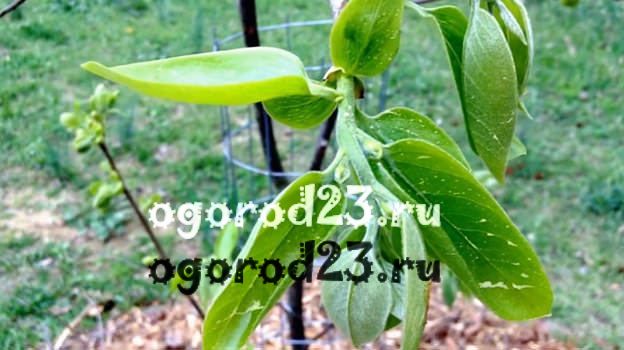
How persimmon grows, where it comes from, what happens, whether it can grow in our gardens - let's look at it in order, let's see the photo. Sweet juicy, bright yellow or orange fruits are the harbingers of the New Year, because they appear on store shelves shortly before the winter holidays.
It is also called persimon - this synonym comes from English-speaking countries. Persimmon is remarkable in that it is absolutely unique, unlike any other fruit. The size, shape, color, taste of fruits vary - it depends on the variety. It can be yellow, orange, red, brown, even green with completely black sweet flesh.
The tree on which the persimmon grows can reach 25-30 meters in height, there are also low, dwarf varieties. The taste of fruits varies from astringent tart to rich sweet. Well-ripened pulp can be eaten with a spoon, but there are some that remain firm even after ripening. There are about 300 species.
Quite often on the forums you can find the question - what is the name of the tree on which the persimmon grows? The answer is expected and prosaic - persimmon! Both the tree and the fruit are called by the same word.
Persimon belongs to the Eben family, the wood of any variety is distinguished by its density, dark color. Parquet, furniture, parts for billiards, sports accessories, musical instruments, dishes are made from it. The leaves are used to make teas such as Gamipcha or Nokchawon.
People often ask the question - what is a persimmon, is it a fruit or a berry? Opinions are often divided, because the large size of the fruit, as well as the size of the tree, hint at a fruity origin. However, juiciness, the presence of multiple large seeds tells us that this is a berry.
Fruits on a tree, photo:
According to the botanical definition, persimon is still considered a berry, however, many people refer to it as a fruit. This is not such a serious delusion, after all, the fruits grow on big tree, so both definitions have the right to exist. These sweet berries are consumed fresh or dried. They make jam, sauces, confectionery, compotes, marmalades, even alcoholic beverages.
This is a dioecious culture, its flowers can be male and female. There are both self-fertile and parthenocarpic varieties that do not need pollination. The flowers are quite inconspicuous, often have a yellowish-green hue, hiding in the axils of the leaves.
How persimmon blooms, photo:
 buds
buds  Flowers
Flowers  ovaries
ovaries In nature, there are both edible and inedible varieties. It is quite unpretentious, frost-resistant, despite the fact that it comes from countries with a warm climate. It is worth noting that some varieties can easily tolerate a drop in temperature to -20ºС and below. If we compare this culture with other fruit representatives, then it begins to bloom later than all the others and only with the arrival late autumn bears fruit.
It is not only tasty, but healthy, contains vitamins, proteins, glucose, fructose, carotene, iron. Persimon is low-calorie, therefore it is an excellent dietary product.
Many of us at least once asked the question: why persimmon knits the mouth? The cell juice of this fruit contains a large amount of tannic compounds - tannins, which are characterized by a pronounced astringent aftertaste. By the way, it is unripe or unripe fruits that contain tannin; this taste is absent in well-ripened fruits. Some varieties, such as the kinglet, contain practically no tannins. If you come across an astringent fruit, place it for a couple of days in the freezer compartment of the refrigerator - it taste qualities will improve significantly, the characteristic aftertaste will go away.
Persimon grows mainly in warm regions - India, Italy, Spain, Georgia, Tajikistan, China, France, Turkey, Africa, and other countries. It is cultivated in Brazil, Algeria, Palestine, Afghanistan, Australia, Israel, Indonesia, Korea, Japan, Vietnam, USA.
China is considered to be the birthplace of this sunny fruit. But he won the hearts of our compatriots. On the territory of the former post-Soviet space, persimmon is also grown and cultivated. Today, we most often sell those fruits that were brought from Abkhazia, North Ossetia, Crimea, Georgia, Caucasus.
Where does persimmon grow in Russia? It grows mainly in the Krasnodar Territory, the Volgograd Region, North Ossetia, the Crimea, and the southern part of Dagestan.
Despite the fact that on Black Sea coast cold snaps also occur, this only improves the taste of the fruit. In our country, mainly frost-resistant varieties are grown. They can withstand very low temperatures (-25..-30 °C), of course, if these cold snaps are short-lived.
The taste characteristics of persimon depend not only on the variety, but also on the place of growth, soil type, humidity level and, of course, temperature indicators in the region.
Photo - how persimmon grows:


The very first frost-resistant variety was bred by scientists scientific center RAS (Nikitsky Botanical Garden). Breeders crossed two varieties (Eastern with Virginia), thereby creating a productive, frost-resistant variety, which they called "Rossiyanka".
The second brainchild was the Nikitsky variety, which was also resistant to cold, gave juicy, sweet fruits of a bright burgundy hue.
They differ not only in shades of taste, but appearance: rounded, elongated, flattened like a pumpkin, similar to a heart, and some of them are so tiny that they resemble a cherry in size. Fruits can be bright yellow, orange, brown, red, brown, even green.
It is also called: kaki, Japanese persimon, Chinese persimmon - this is the most common type, it is most often sold on store shelves, markets. This specimen is an ornamental deciduous tree that can reach a height of ten meters. The fruits are removed at the stage of coloring in yellow, at room temperature they can reach the state of full maturation. The weight of the fruit is approximately 50-100 g. Oriental Persimon can be frozen, and also stored for quite for a long time(about 6-7 months).
Eastern persimmon, photo:

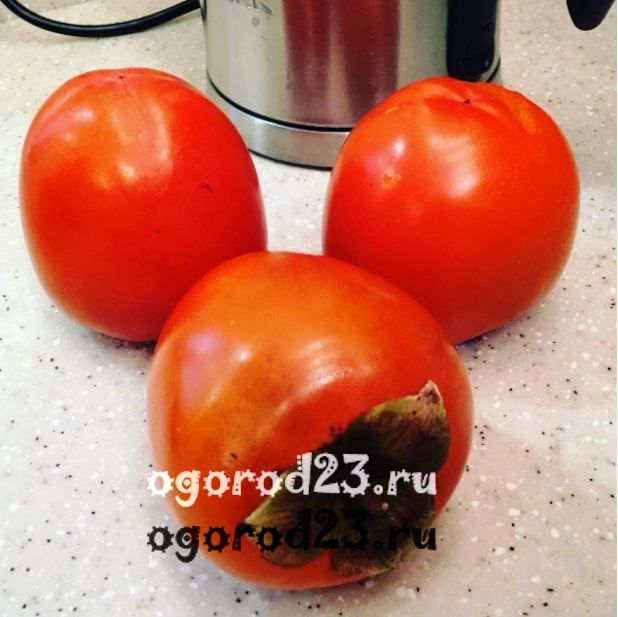 Oriental
Oriental Oriental delicacy - dried persimmon is most often made from this variety. The bark, foliage, as well as the fruits can be used for medicinal purposes. This is a frost-resistant crop that can easily survive temperatures down to -17°C, but dies at -23..-25°C. It is not capricious to the ground, loves moisture (but not waterlogging, for example, marshy soils). The tree blooms around May or early summer, bears fruit in autumn - by September-November.
It is called the velvet apple or mabolo. The fruits look very attractive, unusual - their skin is covered with velvet villi. At the initial stage of ripening, the color of the fruit has a brown color, and then becomes bright red. The flesh is pink, juicy, sweet, but the taste itself is a little specific, with a cheesy tint. Fruit weight varies from 80 to 500 g. Unpleasant odor can be removed by removing the velvety peel and then placing the fruit in the freezer (for 3-5 hours). This variety is often used for making sauces, salads, stews with various types of meat. The tree can reach 20 meters in height, very productive in terms of fruiting. It is also often used as an element of landscape decoration.
Variety Velvet, photo:

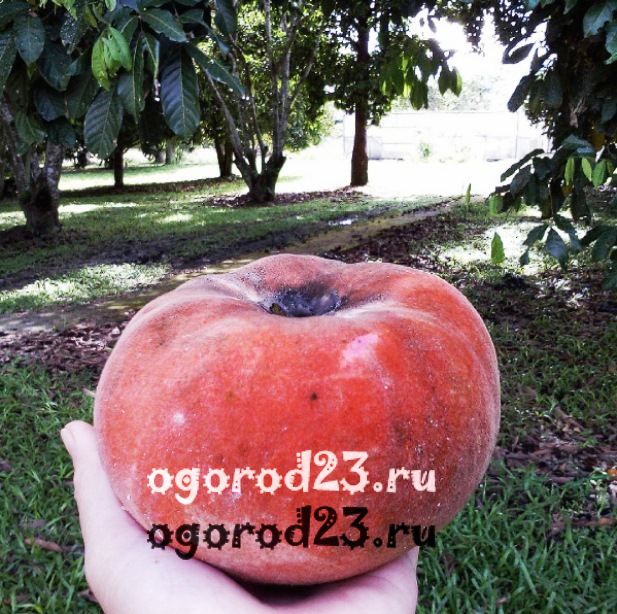 Velvet (Mabolo)
Velvet (Mabolo) Mabolo is grown on an industrial scale, its homeland is the Philippines, in Taiwan, Malaysia it is widely cultivated.
Wild representatives of this species grow in North America. The tree is similar in size to the oriental variety, but the fruit is slightly smaller (30-50 g), but twice as sweet. The taste is sweet, juicy, characterized by a spicy rum shade. In its native open spaces, this cultivar can withstand short-term temperature drops to -27..-30°C. Virginian persimon cuttings are often used as rootstock.
Variety Virginsky, photo:

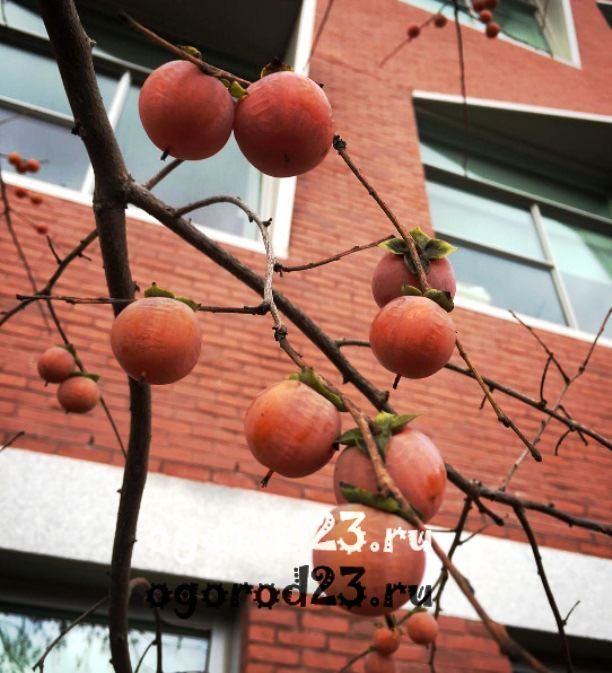 virginskaya
virginskaya This species is considered the most frost-resistant.
This is the smallest persimmon, its fruits resemble grapes or cherries in size. It grows on the Black Sea coast of the Caucasus, in Azerbaijan, the Crimea, and Central Asia. It blooms by May, and by the end of September-beginning of October it is already bearing fruit. Small berries repeat their Eastern counterpart in everything, the difference is only in size, but it is significant. The fruit contains many seeds, tastes somewhat like a date (at the stage of full ripening).
Variety Caucasian, photo:
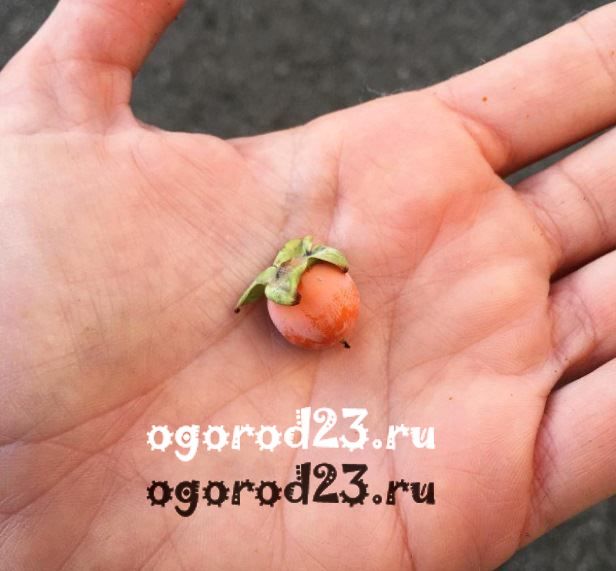
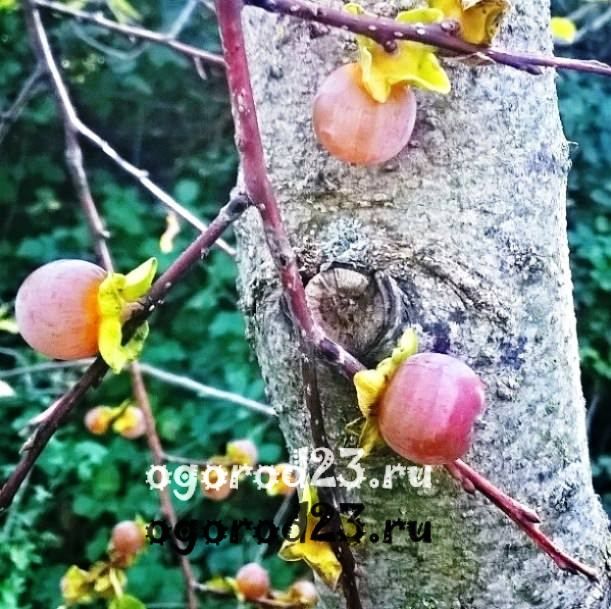
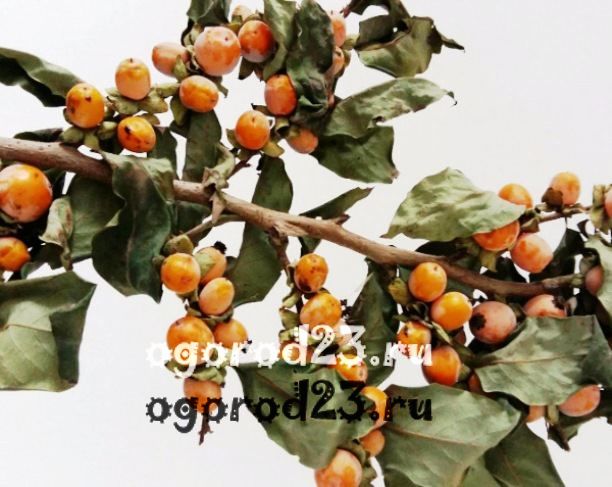 Caucasian
Caucasian It is often used as the rootstock of the Eastern Persimon, after which the trees become hardy, more durable.
This is a hybrid variety - the brainchild of the Nikitsky Botanical Garden, very frost-resistant. An adult representative can withstand temperatures down to -27..-32 °C. In our open spaces, the tree grows up to 4 meters in height, gives rather large yellow-orange fruits (100-140 g), begins to bear fruit in the third year of life. This is a hardy, "hardened" variety, resistant to many diseases. A feature is the ability to bear fruit without pollination, since the flowers of the Russian woman are exclusively female. The tree loves moisture, needs frequent watering, produces a crop around the end of November.
Variety Rossiyanka, photo:
 Russian woman
Russian woman The fruits are harvested hard, their ripening occurs during further storage, then the fruits become especially sweet. This variety has three varieties - the first one has no seeds, and the flesh has a light color. The second subspecies has rather small grains, the third one grows in the Crimea, it has no seeds, and the peel has a reddish tint. The Russian woman took the best qualities from her ancestors, becoming one of the most popular and leading representatives of modern selection.
This cute name combines several persimon varieties that are similar to each other. It has a mild sweet taste, almost no astringent effect. Fruits with a brownish color of the skin and pulp are called "chocolate kinglets", but there is a yellow variety of them - Honey Kinglet. Fruits ripen by October, their shape can be round, slightly flattened or resemble a heart in shape.
Persimmon variety Korolek in the photo:
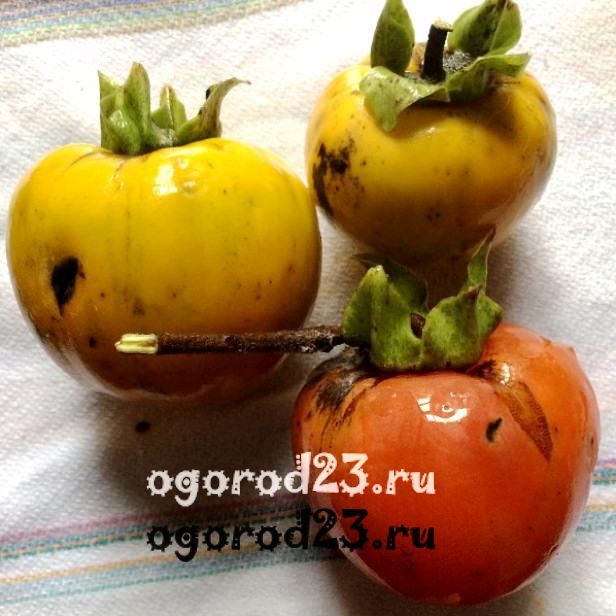
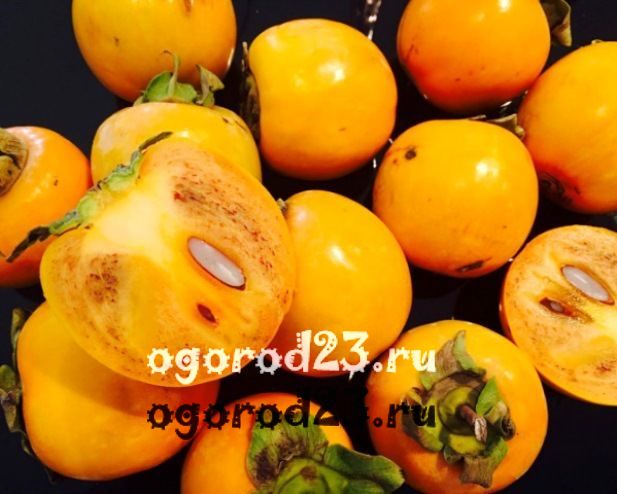
 Wren
Wren While the fruit is not ripe, it contains a lot of tannin, but as it ripens, this feature disappears. The kinglet is very tasty, it is used to prepare various sweets, as well as alcoholic beverages. Dried, finely ground grains successfully replace coffee, which has a spicy taste, plus it is also healthy.
This is the Chocolate King, with a pronounced dark brown pulp, it is noteworthy that the darker the shade, the sweeter its taste. According to most, this variety is considered the sweetest of all. existing species. This persimon has a lot of seeds, the skin is thin, orange, through which you can see the dark flesh. The fruits grow to the size of a large apple, their weight can reach 600-800 g. Feature lies in the color of the fruit itself - if it has been pollinated, then the fruits will differ in sweetness, the presence of seeds. If pollination has not occurred, then the persimon will have a lighter shade, some viscosity in taste, it will not have seeds. Such different specimens may well coexist on the same tree.
Persimon chocolate color, photo:
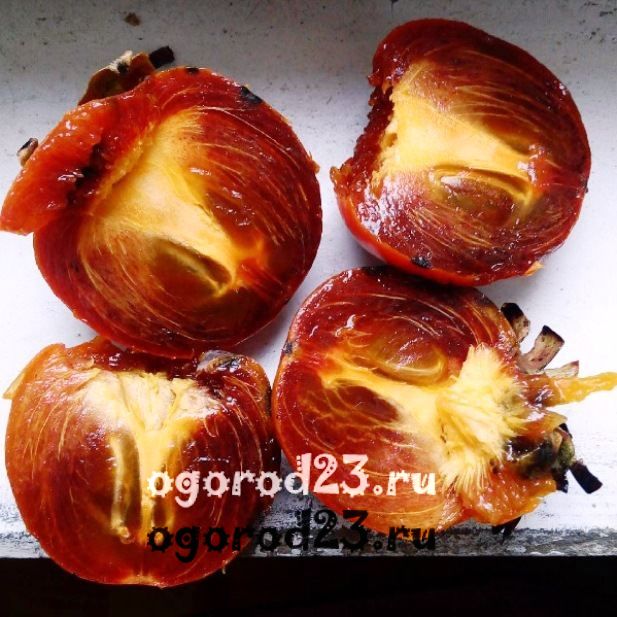
 Korolek Chocolate
Korolek Chocolate Harvest ripens by October or early November. This variety is grown in warm regions Ukraine, Russia, in the Crimea, in the Caucasus.
We used to call the brown Kinglet a chocolate variety, but in nature there is another species that is worthy of attention. This exotic species deserves the name “chocolate” more than anyone else. We are talking about the Black Sapote variety, which in the Russian-language version is called Black Persimmon, Black Apple, Black Sapote. It is also called chocolate pudding, because its pulp tastes really very similar to this dessert.
Black Sapota, photo:
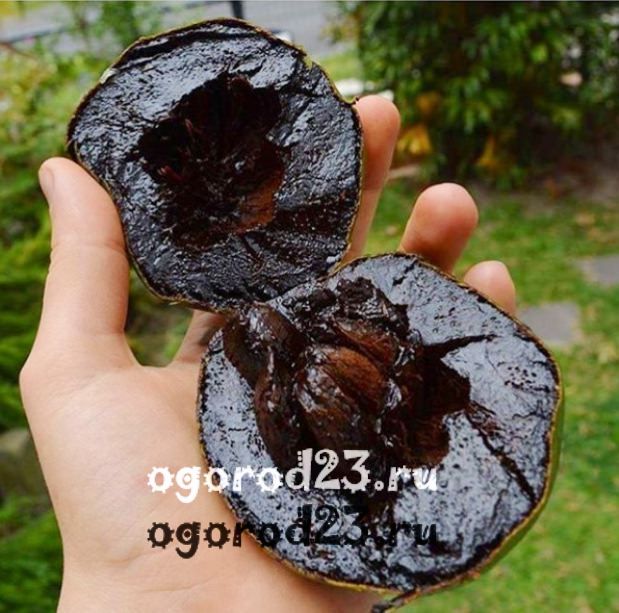
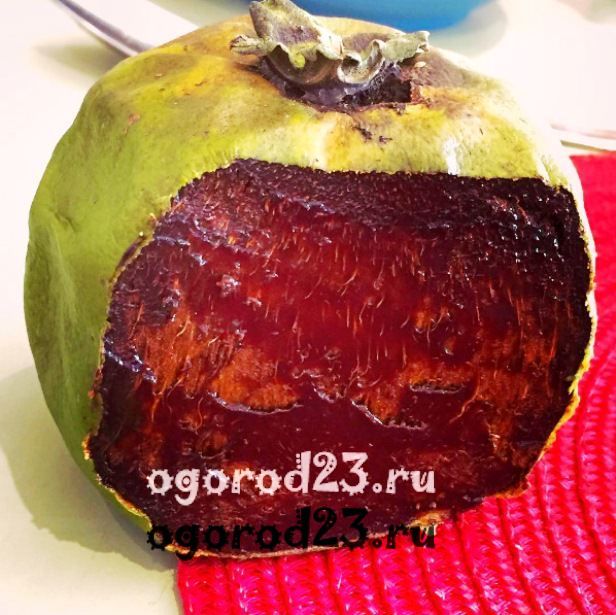 Black Sapoto
Black Sapoto It comes from Mexico, where it is also cultivated. Today it is grown in the Philippines, Hawaii, Antilles (Antilles), Mauritius. The skin of the fruit has a rich green color and the flesh is completely black.
This or that variety is, as it were, the hallmark of the country where persimmon grows. Thus, the Russians can be proud of the Rossiyanka and Nikitskaya varieties, the Ukrainians of the Roman Kosh and Mider varieties, the Filipinos of Mabola (or Velvet).
If you set out to plant persimon in your home, then it is better to opt for frost-resistant varieties. If you know how persimmon grows, what care it requires, how to cover it during the winter, then the likelihood of growing sweet sunny fruits becomes quite real.

Starting the cultivation of new plants, the gardener is usually faced with many questions, the answers to which are not easy to find. So we did it with persimmon. Today, we have to state with bitterness that throughout the entire persimmon, the plant is southern, subtropical in origin.
These are her biological features persist, despite a significant advance to the north. So, if for most agricultural crops in the Crimea, average daily temperatures above 10 ° C are considered active, then for persimmons, the night temperature is 5 ° C, and the daytime temperature is 15 ° C - far from ideal conditions. Despite all the weather disasters ( winter frosts and thaws, ice, returns of cold weather) persimmon on the rootstock of virgin persimmon forms a normal crop, especially the varieties of the Nikitsky Botanical Gardens (Rossiyanka, Nikitskaya burgundy, Sputnik, etc.).
Persimmon blooms at the same time as grapes. Usually the beginning of the flowering of grapes in the Crimea falls on June 2-5 and lasts until the twentieth. Remember that a seedling, especially a spring planting, always blooms much later than a tree growing in a permanent place. He, unlike a tree, needs to heal all injuries, grow wounded 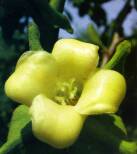 roots to adapt to the changing microclimate. Therefore, do not rush to uproot the seedling.
roots to adapt to the changing microclimate. Therefore, do not rush to uproot the seedling.
Doubt whether he got accustomed or not? Take a pruner and trim the ends of the shoots by 2-3 cm. Dry? Another 2-3 cm, and so on until the "green", i.e. to living tissue. If living tissues are above the grafting site, then everything is in order, if not, well, you will have to plant again.
 Persimmon flowers are female and male. Female flowers are quite large, with wide-curved petals, have four pistils with openwork-forked stigmas, a large calyx with four sepals, which are almost twice the size of the corolla petals. Male flowers are small, bell-shaped, arranged in the form of three-flowered tassels, with a large number (more than twenty) of stamens with long anthers. Their calyx is small, the sepals are shorter than the petals, the inconspicuous greenish-yellowish color of which does not prevent insects from actively transferring pollen to its intended purpose. However, many varieties of persimmons, having no male flowers, are able to produce parthenocarpic seedless fruits without pollination. They are more tart in technical ripeness, but when fully ripe, this disadvantage disappears.
Persimmon flowers are female and male. Female flowers are quite large, with wide-curved petals, have four pistils with openwork-forked stigmas, a large calyx with four sepals, which are almost twice the size of the corolla petals. Male flowers are small, bell-shaped, arranged in the form of three-flowered tassels, with a large number (more than twenty) of stamens with long anthers. Their calyx is small, the sepals are shorter than the petals, the inconspicuous greenish-yellowish color of which does not prevent insects from actively transferring pollen to its intended purpose. However, many varieties of persimmons, having no male flowers, are able to produce parthenocarpic seedless fruits without pollination. They are more tart in technical ripeness, but when fully ripe, this disadvantage disappears.
Persimmon begins to bear fruit at 4-5 years, and with normal care, the yield increases rapidly. Like many other crops, it requires crop rationing, the fruits should be located no closer than 10 cm and not touch each other, then they will grow large and tasty. 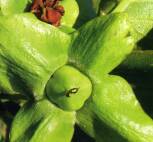 Kilograms will not decrease, but the presentation of the fruit will improve significantly. When the crop is overloaded, the fruits become smaller, become tasteless, the tree is depleted, it lays few flower buds, a periodicity of fruiting appears, which is then quite difficult to overcome. In addition, an exhausted, weakened tree endures winter worse and can not only freeze slightly, but also die.
Kilograms will not decrease, but the presentation of the fruit will improve significantly. When the crop is overloaded, the fruits become smaller, become tasteless, the tree is depleted, it lays few flower buds, a periodicity of fruiting appears, which is then quite difficult to overcome. In addition, an exhausted, weakened tree endures winter worse and can not only freeze slightly, but also die.
V. P. Chernyaev, L. N. Kazas, E. L. Shishkina - authors of new winter-hardy persimmon varieties- conducted a lot of research confirming the possibility of growing persimmons not only in the Crimea, but also in the south of Ukraine (from the mouth of the Danube to Mariupol). It must be said that it has "advanced" to the north as far as Novaya Kakhovka, and is slowly "making its way" to Donetsk and Dnepropetrovsk. Subtropical fruits remind many of us of fairy tales about distant countries. Mango, persimmon, pineapple... The names alone are worth something! And, although the markets today are full of exotics, it is very tempting to grow them yourself, in your garden. And available! Everywhere you can find microzones suitable for growing this amazing crop.
In Crimea, persimmon fruits ripen from October to November, depending on the variety.
To be transported over long distances, the fruits are harvested when they are still firm, but already have an orange-yellow color. If you remove them too early, that is, still green, then when lying down, the fruits ripen slowly, shrivel, wither strongly and have a bad taste.
For local consumption, the fruits should be harvested as late as possible, when they turn into an intense (typical of the variety) bright orange, red, burgundy color and slightly flatten when pressed.
Weak autumn frosts do not impair the quality of fruits that have accumulated a lot of sugar. They are firmly attached to the tree, so they need to be cut with secateurs or scissors. When detached, the fruit may come off the calyx and soon rot. The fruits must be removed carefully, always with a cup, avoiding dents, scratches and other damage. Carefully harvested fruits are better stored and do not soften prematurely. The stalk should be cut closer to the calyx, as a long stalk during storage can damage other fruits. The fruits taken from the tree are placed in boxes in one layer with cups down so that they do not touch each other.
Fruits are stored in a well-ventilated, sufficiently humid, cool and dark room, where they gradually ripen, soften, and lose their astringency. If the air in the room is too dry, then the persimmon fruits do not soften during storage, but dry out, wrinkle, and their taste deteriorates.
In a bright room, fruit ripening slows down, with an increase in temperature it happens faster. From time to time, boxes with fruits should be checked, ripened, completely softened fruits should be selected for use in food. Fruits can be stored in refrigerators for two to three months or more. Optimum temperature storage 0-1°С at relative humidity air 85-90%. Frozen fruits can be stored even longer; before use, they are thawed in cold water.
For transportation over long distances, it is advisable to pack round-shaped fruits in boxes in no more than 3-4 layers, and preferably in 2 layers. The fruits are spiky (as, for example, in the Khachia variety) are placed in one layer. At the bottom of the box, as well as between the layers, wood chips or other packaging material is poured, which also fills all the voids between the fruits. Each fruit must be wrapped in soft paper. The first layer is placed cups down, the second - up, the third - down, the fourth - up.
It is well known that the pulp of all varieties of Japanese persimmon by the time of full ripeness (complete softening) loses its astringency. In solid form, only the so-called kinglets and fruits of intolerant varieties are edible. To eat all the rest, you need to wait until they soften naturally, but you can use artificial methods of ripening, in which the fruits lose their astringency, while remaining firm.
Persimmon fruits are rich in sugars (up to 25.9%), represented mainly by glucose and fructose. Sucrose, as a rule, is low in them, therefore persimmon is classified as a dietary product. In dried fruits, the amount of sugars reaches 62-65%. Persimmon is rich in vitamin C (depending on the variety, Crimean persimmon fruits contain 6.5-87.5 mg%), carotene (1.49-6.33 mg%), organic compounds of potassium, calcium, iron (2.5 -4 mg%), iodine (49.7 mg%). Persimmon fruits contain 25 macro- and microelements, nine of which are necessary for the human body. Trace elements copper, zinc, manganese, molybdenum contained in fruits are part of enzymes and hormones.
There are few acids in persimmon (no more than 0.5%), there is protein (up to 1.2%), fats (up to 1%). According to taste, nutritional, dietary and healing properties oriental persimmon ranks second after citrus fruits.
Description of persimmon varieties according to the works of the Nikitsky Botanical Garden:
Hyakume (Kingling)
An old Japanese variety. Belongs to the group of varying. The tree is vigorous. Flowers form only female and in large numbers.
The fruits are orange, round, large (weight 200-400 g). The color of the pulp in seed specimens is brown, in seedless specimens it is yellow, the pulp is jelly-like, juicy, of excellent taste. Seed specimens are edible in solid form. It can bear fruit without pollination, but then the fruits will be yellow-fleshed, but tart when firm. The yield is high. One of the best varieties in the Crimea. Yellowing of fruits - in early November.
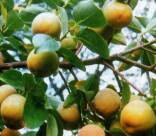 An old Japanese variety. Belongs to the group of varying. The tree is medium. Flowers form female and male (in large numbers). The fruits are round or oblong-round, small (weight up to 100 g). The pulp is dark brown, dense, juicy, very sweet, good taste. It does not need pollination, and forming a large number of male flowers annually, it itself serves as a pollinator. Yellowing of fruits - at the end of October.
An old Japanese variety. Belongs to the group of varying. The tree is medium. Flowers form female and male (in large numbers). The fruits are round or oblong-round, small (weight up to 100 g). The pulp is dark brown, dense, juicy, very sweet, good taste. It does not need pollination, and forming a large number of male flowers annually, it itself serves as a pollinator. Yellowing of fruits - at the end of October.
Russian woman
An interspecific hybrid, obtained in the Nikitsky Botanical Garden in 1959 as a result of crossing persimmon virgin and eastern. Belongs to the group of constants. The tree is medium. Forms only female flowers. Can bear fruit without pollination. The fruits are yellow-orange, with a wax coating, flat-round, small (40-65 g]. Firm fruits are tart, edible only after complete softening "in the maturation". When fully ripe, the flesh is thick, jam-shaped, pleasant to the taste, very sweet ( sugar content up to 25%), with a delicate aroma. Few seeds. From virgin persimmon, the variety inherited increased frost resistance. It has been growing for 30 years and regularly bears fruit near Simferopol and Sevastopol.
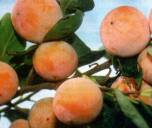 Selected from seedlings of the Rossiyanka variety. For the first time it bore fruit in 1980. The tree is medium-sized. The fruits are flat-round (weight 70-130 g), firm, bright red-orange in color with a noticeable wax coating, the pulp is tart. The ripe fruit is dark red. The pulp is very sweet, with a peculiar aroma. Can bear fruit without pollination. Fruiting is annual. The yield of a 6-year-old tree is up to 20 kg. Like the Rossiyanka variety, it is more frost-resistant than the eastern persimmon varieties. The variety is suitable for cultivation throughout the Crimea. Yellowing of fruits - in early November.
Selected from seedlings of the Rossiyanka variety. For the first time it bore fruit in 1980. The tree is medium-sized. The fruits are flat-round (weight 70-130 g), firm, bright red-orange in color with a noticeable wax coating, the pulp is tart. The ripe fruit is dark red. The pulp is very sweet, with a peculiar aroma. Can bear fruit without pollination. Fruiting is annual. The yield of a 6-year-old tree is up to 20 kg. Like the Rossiyanka variety, it is more frost-resistant than the eastern persimmon varieties. The variety is suitable for cultivation throughout the Crimea. Yellowing of fruits - in early November.
In the Nikitsky Botanical Garden, during the tasting of softened fruits, the fruits of the varieties received the highest rating: Nikitskaya burgundy - 4.7 points (on a five-point scale), while Khiakume and Rossiyanka only 4 points.
In the spring of 1992, seeds obtained from free pollination of the Nikitskaya Bordovaya variety were sown. Seedlings in 1996-1998 began to bear fruit. The three best seedlings were named.
Seedling No. 1 (Goverla Mountain)
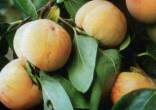 Fruits are flat-round, large (weight up to 250 g), firm, orange. The pulp is tart. The ripe fruit is orange-red. The pulp is jammy, sweet, there are very few seeds. Bears fruit annually. The yield of an 8-year-old tree is up to 30 kg. Yellowing of fruits - at the end of October. Seedlings of this form, grafted on Caucasian persimmon, were received by gardeners from different regions of the Crimea, Kherson region. There, in various soil and climatic conditions, they will be tested for winter hardiness in order to move the persimmon to the north.
Fruits are flat-round, large (weight up to 250 g), firm, orange. The pulp is tart. The ripe fruit is orange-red. The pulp is jammy, sweet, there are very few seeds. Bears fruit annually. The yield of an 8-year-old tree is up to 30 kg. Yellowing of fruits - at the end of October. Seedlings of this form, grafted on Caucasian persimmon, were received by gardeners from different regions of the Crimea, Kherson region. There, in various soil and climatic conditions, they will be tested for winter hardiness in order to move the persimmon to the north.
Seedling #3 (Mount Rogers)
The fruits are flat, oval-quadrangular in projection. The pulp of hard fruits is tart. The ripe fruit is orange-red. The pulp is jammy, moderately sweet, with a delicate pleasant aroma. A 7-year-old tree yielded 25 kg. The fruits turn yellow in early November.
Sydney
American variety from the group of constant. Flowers form only female. Fruits are round-quadrangular, flat (weight 90-150 g). Hard fruits are tart, the pulp of a ripe fruit is jammy, very sweet. The variety can bear fruit without pollination, the fruits do not contain seeds. Yellowing - in early October.
Shagotsu-Gaki
Monoecious variety from the group of varying. Due to the length of the flowering period, it is good as a pollinator. Fruits regularly.
Fruits of a wide-conical shape, large (weight - up to 210 g). The pulp of a mature fruit, in the presence of seeds, is dark orange with a brown tint, thick marmalade consistency, moderately sweet. Yellowing of fruits occurs in early November.
Satellite
Monoecious variety of selection of the Nikitsky Botanical Garden from the group of varying varieties. A good pollinator, regularly and well fructifies. The fruits are round-ribbed, the average weight is 102 g. The fruits are always with seeds, edible in solid form. The pulp of a ripe fruit is jammy, moderately sweet. Yellowing of fruits - at the end of October.
Dream
Variety of selection of the Nikitsky Botanical Garden from the group of constant. Obtained from crossing Kuro-Kuma and Fuyu. Monoecious form with a predominance of female flowers, as a result of which it does not need pollination. The fruits are round-flat, the average weight is 187g. The pulp of a mature fruit is red-orange, very sweet, jam-like consistency, without fibrous. Yellowing of fruits - at the end of October.
Ukrainian
Seedling of the Tsuru-no-ko variety. A monoecious plant from the group of variables, therefore it does not require the planting of pollinators. The fruits are cylindrical with a conical top, the average weight is 100 g. The pulp of a mature fruit is jam-like, juicy, very sweet, of excellent taste.
Nikitsky excellent
One of the earliest varieties in the Crimea (Fuyu clone). Monoecious form from the intolerant group, regularly and well fructifies, an excellent pollinator. The fruits are round-flat, the average weight is 91g. The fruits are sweet in solid form, turn yellow at the end of October.
Variety of virgin persimmon. Judging by the description given in the American source, it does not need pollination. The variety is productive. According to literary sources, the weight of the fruit is up to 100 g. In my garden, it bears fruit for the second year. The mass of fruits did not exceed 50 g, the shape was flat-round. Astringency disappears only after complete softening - in this state they are very sweet, with a pleasant aroma. The color of the fruit is orange, the fruits acquire full color in early November. 
Variety of virgin persimmon. Similar to the previous variety, but the fruits are more brightly colored - with a burgundy blush on the sunny side. The pulp of ripe fruits is very sweet, with a pleasant aroma.
Yuri BOGDANOVSKII, amateur gardener, Feodosia
Vladimir and Nina Volkov
According to the materials of the magazine "Ogorodnik" No. 10/2002, No. 11/2004
Oriental persimmon is one of the subspecies of persimmon. It sprouts just like the rest - on trees. Oriental persimmon came from Asia. It is grown only in a few countries of the world, mainly in the east. But it is imported to almost all points of the globe.
The main crop of oriental persimmon is brought in October, they fall off in just a month.
The fruits of the plant have a dirty yellow skin tone, and are similar in size to apples. Titanin predominates in persimmon, which provides the fruits with a bitter, tart taste. Fortunately, you can get rid of it if you leave the persimmon to lie down for a while in the cold or just in the refrigerator.
Most often, oriental persimmon is eaten as a separate fruit. It is cut into slices or just bite. But you can also use it in culinary dishes.
Despite its similarity to apples, persimmon is twice as useful as them. Since it contains much more dietary fiber, which positively affects digestive system. And because of the high content of sugar and glucose, oriental persimmon helps to improve heart health.
However, it is precisely because of these components that it should not be consumed by people suffering from diabetes or obesity. Oriental persimmon fruit juice can reduce blood pressure. In the east, this fruit is considered healing. It is prescribed for all diseases. It is believed that oriental persimmon is really capable of healing, because it contains an incredible amount of useful trace elements. Oriental persimmon helps to bring a person's nervous state to a resting position, and also stabilizes blood pressure.
How to grow a persimmon from a seed and in open fieldWho does not love this oriental sweet fruit. Many people ask the question, is it really possible to grow this heat-loving tree with us? How realistic! I found some tips for growing from seed indoors and growing in our harsh climate in the open field. So .. What kind of fruit is this?Persimmon, or Diospyros (lat. Diospyros) is a genus of subtropical deciduous trees ebony family. In many species, the fruits are edible - they are large orange fleshy 2-10-seeded berries.
Other names: wild date, date plum.The Latin name of the genus, Diospyros, can be translated as "food of the gods".
Homeland - China. It is widely distributed in Japan and is famous for its magnificent fruits. Common or Caucasian persimmon (D. lotus), eastern persimmon (D. Kaki), more winter-hardy virgin persimmon (D. Virginia) are common in culture; breeders have obtained many varieties. Persimmon is propagated by seeds and grafting on seedlings of the Caucasian and Virginia persimmons.
More than 200 types. One of the popular varieties is "King".
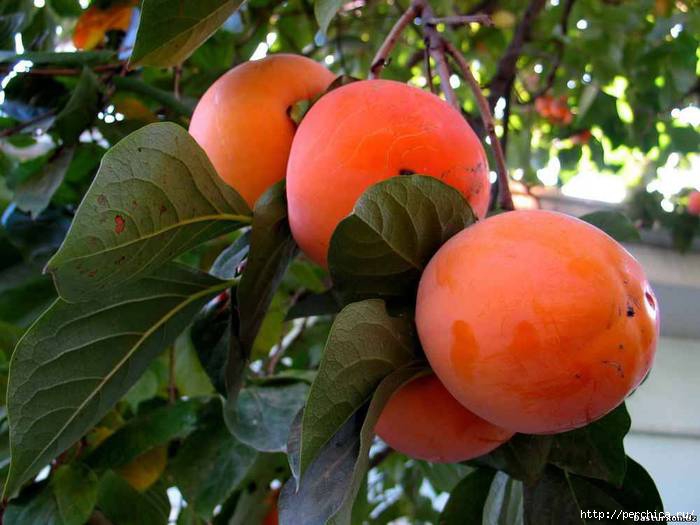
Persimmon trees are long-lived: plants found in China are 400-500 years old. The persimmon fruit tree reaches a height of 8-12 meters and is completely strewn with large (up to 8 cm in diameter) fleshy fruits. various shapes; its yield is about 250 kg. Persimmon, formed in the form of a small tree, has a decorative appearance due to the variegated color of the leaves before falling off and the long-hanging fruits on the tree after the leaves fall off.
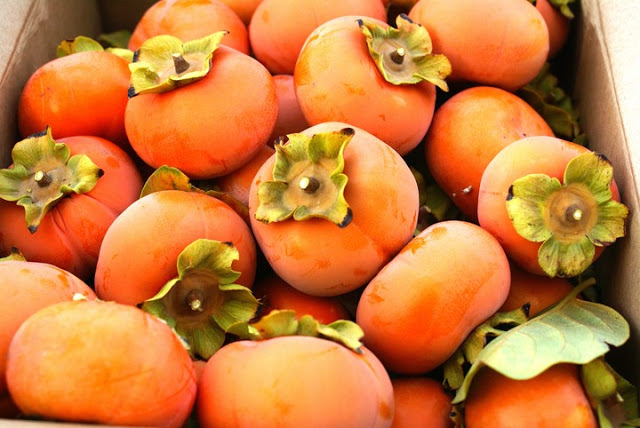
The leaves are dark green, turning red before falling off, 8-12 cm long, 4-6 cm wide.
Depending on the variety, the flowers are dioecious, monoecious and rarely bisexual. Female flowers are large, solitary; males are small, sit in groups of 3-5 on short thin shoots.
Varieties are divided into three groups: with female flowers (Hiakume, Hachia, Gosho-gaki), with male and female flowers (Geiley, Zenji-maru), with female flowers, forming a small number of male flowers in some years (Fuyu). These varieties can be divided into three more groups: tart, astringent (Hachiya, Seedles, Tamapan, Tanenami), sweet, non-astringent (Fuyu, Chinebuli, XX century), changing taste depending on the pollinator (Hiakume, Gosho-gaki, Zenji-maru , Gailey, Tsurunako).

The fruit is a large fleshy berry 6-8 cm long and 4-5 cm wide, orange or red skin with a waxy coating. The color of the pulp depends on pollination - when pollinated it has a dark color. The weight of the fetus ranges from 200 to 300 g.
Persimmon is called the "plum of the gods" for its amazing sunny golden-orange fruits with sweet - tender jelly-like or dense (in some varieties with a brown tint) - pulp and a delicate aroma reminiscent of apricot. Juicy persimmon fruits are not only beautiful and tasty, but very healthy and considered healing: they contain sugar, vitamin C, iron and other valuable vitamins and minerals.
The ripening period occurs in some varieties at the beginning, in others - at the end of October. More often, ripening coincides with the first frosts, after which the fruit only becomes tastier.
So, how to grow persimmon from the seed yourself.
The bones from the freshly eaten fruit are washed, dried and placed in a pot with soil to a depth of 1-2 centimeters (there is an experience of germinating persimmon seeds in cotton wool), covered with plastic wrap and sent to a warm place. Since persimmons are eaten most often in autumn-winter period, you can put a pot with a bone on the battery.
Persimmon sprouts easily, but it has a very strong bone, sometimes after germination, the sprout has to be helped and carefully cut off the shell so that the leaves are exposed. Such a persimmon can begin to bear fruit in the 6th year, and if you live in the southern regions, then it can be safely planted on a personal plot.

Seeds germinate in 1-2 weeks. It's almost useless to keep more. A pot covered with cellophane must be periodically ventilated, water should be added as the soil dries by 1.5 centimeters. After a sprout appears, the cellophane can be removed.
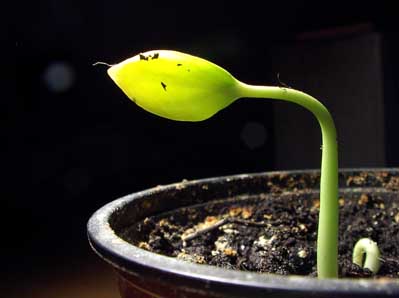
Persimmon sprout is quite long - 10-15 centimeters. A bone may remain at the end of the sprout. Its valves are very tightly closed, and if the stone does not fall off within a couple of days, the sprout may die. Therefore, you can gently help the sprout get rid of the bone. You can do this with a sharp knife, needle or scissors, if the bone sits very tightly, you need to steam it (spray it, place it in a plastic bag and put it in heat overnight), after which the bone will be removed much easier.

Sprouts grow very quickly, so you need to often transfer to large pots. Lack of space for a rapidly developing root system can lead to the death of the plant.
With a lack of substrate, the leaves stop growing, turn yellow.
Care
In the summer, care consists in keeping the tree, if possible, in a well-lit place, in the yard or on the balcony. In order to avoid burning the leaves, the plant is gradually accustomed to new conditions, in the first week it is slightly shaded. During the growing season, fertilizing is carried out 2 times a month. In autumn, in October - November, they are transferred to a room with a temperature of + 3-5 degrees Celsius or a cellar. The soil is covered from above with a layer of wet sawdust and systematically sprayed so that the earth does not dry out. In February-March, transshipment is carried out, if necessary, watered abundantly and placed in a bright place.
Form young seedlings into small trees. At the level of 0.3-0.5 m, a pinch is made for branching. 2-3 apical shoots are left, and when they reach 20-40 cm, they are pinched to form branches of the 2nd order, 2-3 branches are also left, etc. They form a rounded tree 1.5 m high. The plant is fast-growing, the first flowers appear in 3-4 years.
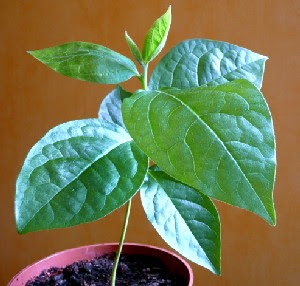
In room conditions or winter garden a persimmon tree usually grows up to 1.5 meters (you can limit its growth with pruning, and crown splendor with regular shaping). In summer, a persimmon tree is placed in a bright and wind-protected place on the street, regularly watered and sprayed; flowering takes place in June. During the active growing season, persimmons are fed twice a month with mineral fertilizers with a low nitrogen content. In winter, persimmons are kept cool (at a temperature of about 5 degrees, not higher than 10 degrees); the soil must be periodically moistened soft water room temperature, and spray the plant. Excessive watering is very harmful and leads to the death of the persimmon tree.
Varieties
According to the quality of fruits, persimmon varieties can be divided into three groups. Varieties of variety, the fruits of which, in the presence of seeds, are sweet even in solid form. This group includes the varieties Hyakume, Zelendzhi-Maru. intolerant varieties. Regardless of the presence of seeds in the fruits, they become sweet and edible in solid form only after acquiring the color characteristic of the variety. Delicious (Excellent Giro) belongs to this group. Constant varieties are always tart in their solid form and are usable when their contents have acquired a jelly-like consistency. This group includes varieties Khachia and Costata (Ribbed). The State Register of Plant Varieties of Ukraine includes one variety - Sputnik. There are also varieties Nikitsky burgundy, Mider, Rossiyanka (self-fertile hybrid).

Elements of agricultural technology
Persimmons should be planted in places protected from the prevailing winds, well-drained and sun-warmed areas of the site without stagnant water. The distance between the trees is 5-7 m. The dimensions of the planting holes are the same as when planting other fruit trees. crown formation Form the crown when the plants reach a height of 1 m. Make sure that the stem height is at least 50-60 cm. To lay the main skeletal branches at a distance of 30-40 cm from the top, unfolded buds are left, the rest are removed. The following year, of the developed shoots, 4-5 of the strongest and evenly spaced around the trunk are retained. The rest are removed. Then, on each branch of the crown of the first order, 2 branches of the second order are left. On the branches of the second order, in turn, there are 2 branches of the third order. care
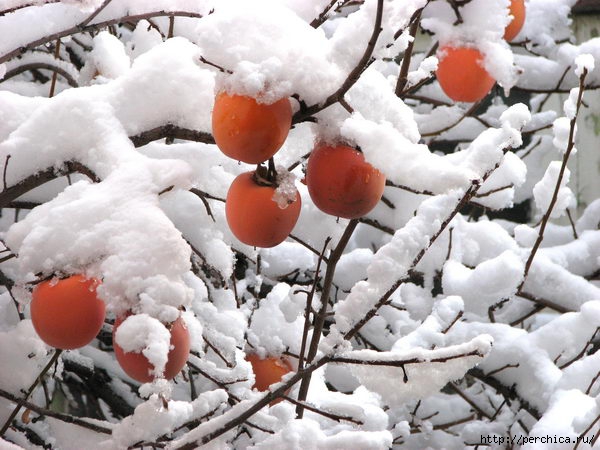
Care
includes the application of 10-30 kg of humus per 10 sq.m (than older tree the more fertilization). If only minerals are introduced, it is necessary to give 20-50 g of nitrogen, 60-90 g of phosphorus and 30-50 g of potassium under one tree.
Fertilizers are best applied in the spring. To give the plants fresh organic matter, in August-September, siderates can be sown, which are dug up in the spring of next year. Siderats improve physical properties soil, enrich it with nutrients, protect it from flushing (water erosion). Since persimmons are grown mainly in arid places, trees should be watered regularly, at least once every 7-10 days. Harvesting Removable maturity occurs when the fruits acquire the color characteristic of the variety. It is necessary to collect fruits with great care, avoiding the formation of dents and scratches on them. It is strictly forbidden to knock down and shake off the fruit from the tree. The difficulty of accurate collection lies in the fact that the persimmon stalk is short and very strong. It is necessary to pluck the fruit with two hands, supporting it with one, and unscrewing the stalk with the other
Store in boxes or baskets. With the onset of frost, the fruits are frozen. As needed, the fruits are immersed in cold water, where they thaw without losing taste and nutritional components. Hard, but already colored fruits can be ripened by immersing in warm (30-35o) water. At the same time, tart-tasting fruits become sweeter. the most interesting Everyone is interested to know what kind of pulp is hidden in the still hard persimmon fruits. It's easy to guess. You need to look at the fruit from above. If the black stripes on the top form several circles, then you can be sure that all the flesh of the still firm fruit is sweet and brown (chocolate) in color. But the strips can only cover a part - half or a quarter of the fetus. And then, where there are circles, the pulp is dark and sweet, and where there are no circles, it is light and tart. It turns out that these circles are associated with pollination. Persimmon has a four-celled ovary. If the bees worked, they conscientiously pollinated the flowers. Thus, each ovary can be pollinated separately. Of course, few people think about the biological secrets of pollination. Male trees do not bear fruit, and they are often cut down, thus the fruits are of poor quality. For whom the black circles-marks are intended - it is not known. But a person widely uses these indicators, preferring to buy exactly kinglets, that is, fruits with a solid ring at the top.
Of course, persimmon for our gardeners is an exotic plant. But, as in any business, there are enthusiasts of its cultivation. Therefore, for beginner gardeners, we recommend the Rossiyanka variety, a hybrid variety that tolerates 35 degrees of frost. The mature fruit weighs 150-170g. The seedling will give its first harvest in two years. Trees under the age of five years bring 15-20 kilograms. Seniors - up to thirty. This tree does not need to be treated with any chemicals. "Rossiyanka" is a hybrid, therefore it bears fruit regardless of gender. Even in the Transcarpathian region, persimmon grows even better than in Rome. Because there is dry air, and she loves moisture.

Persimmon genus (Diospyros, Diospyros L.) belongs to the ebony family, numbering, according to V.I. Grubov (1952), about 290 species; according to other sources (MD Omarov, 1994), there are about 450 species growing in the tropics and subtropics, which are mainly of technical and decorative value. Some species of this genus produce excellent ornamental wood and are known as "black" or "ebony" wood. Diospyros translated from Latin ( according to other sources (Grekov S.P.) from Japanese) - a divine fruit, the food of the gods.
Whole genus Diospyros L has a large number of species in South Asia, Africa, Australia - in tropical regions. Over 40 species of persimmon are found in Japan, and 30 in China. There are many wild thickets of plants in the mountains of the middle part East Asia. In the forests of India, persimmon Blackwood is common, in China - Rhomboleaf, in the mountainous part of Western China in
wild Chinese persimmon grows - a species close to Eastern. In Russia, persimmon culture is common throughout the Black Sea coast, in Dagestan, as well as in Georgia, Azerbaijan, Armenia and Central Asia.
Cultural forms of persimmon originated from the natural crossing of these two varieties. From the end of the 19th century persimmon began to spread in the Mediterranean countries. In fruit growing, three types of persimmons are essential: Caucasian ( D.lotus), virginian ( D.virginiana), Eastern ( D.kaki).
Persimmon Caucasian (common) (D.lotus) is found in forest thickets in China and Japan, in the CIS - in Transcaucasia and in plantations of the Crimea. Caucasian persimmon was brought to America relatively recently and is known there under the name Italian persimmon.
The fruits of the Caucasian persimmon are eaten fresh and dried, used in cooking, for distillation of alcohol. Wood is most often used for various crafts, it is durable and slightly susceptible to decay. The height of trees when grown in open ground in the subtropical region reaches from 5-8 to 15-20 m. The fruits are small, very tart when unripe, sweet when dried, astringency disappears during the ripening period. The fruit contains about 30% water, the rest is dry matter, including: nitrogen-containing - 2.3%, monosaccharides - 40%, acids - about 1%, the rest - ash.
In the fruit growing of China, Japan, the Mediterranean, the CIS countries, the Caucasian persimmon is used as a rootstock of the Eastern persimmon. The Oriental persimmon trees grafted onto this stock are distinguished by their longevity. Caucasian persimmon is a good rootstock in more northern regions.
Persimmon oriental (Japanese) (D.kaki L.) - Japanese persimmon, subtropical or eastern, originally from Northern China, first introduced into culture in the countries of East Asia. It was brought to Europe in the middle of the last century, and to Russia from France in 1819 to the Nikitsky Botanical Garden by H.H. Steven. AT Krasnodar region introduced to Sochi from Sukhumi in 1894, from the garden of P.E. Tatarinov. Japanese persimmon in culture is common in Japan, Korea, China. This fruit plant comes from East Asia (E.N. Sinskaya, 1969).
Persimmon orientalis is a fast growing, deciduous tree. The crown is loose, spreading. The bark of old persimmon trees is brown, while young shoots are pubescent. Smooth shiny leaves vary in shape from oblong-oval to oval-elliptical. In autumn, before falling off, they have a color from yellow-orange to red. Flowers unisexual or bisexual; female - solitary, yellowish-white, large, have a four-lobed calyx; male - smaller, bisexual, located in groups of 2-3 flowers on thin shoots of the current growth, colonial, with strongly fused corolla petals. Trees can be either monoecious or dioecious. In Crimea, oriental persimmon blooms in the second half of May. It is pollinated by the transfer of pollen by insects from male flowers to female flowers. The fruit is a berry large size, varying in shape and color. Most often used fresh. Ripe fruits are very juicy and sweet.
Persimmon virgin (D.virginiana) is found wild in the United States, used as a rootstock for the Eastern persimmon. Virgin persimmon, in comparison with the Caucasian, has larger fruits. In an unripe form, they are tart, their chemical composition: dry matter - 35%, sugar - 32%, protein substances - 1%, ash - 0.8%.
Sweet fruits are eaten fresh, and to eliminate the astringent taste of a number of varieties, they are kept in water for about 12 hours at a temperature of 30-40 ° C (L.Ya. Sklyarevsky, 1975).
The astringency and medicinal value of persimmons are due to the content of phenolic compounds in them. Unripe persimmon fruits are rich in tannins (up to 25%). As the fruit ripens, the tannin content gradually decreases. When the content of tannins in fruit juice with a concentration of less than 10 mg per 100 g of juice, the fruits become non-astringent.
The nutritional value of persimmon fruits is determined by their high sugar content. On average, per fresh weight, the persimmon fruit contains up to 14.79% sugars (12-18% in terms of wet weight) (with a predominance of glucose). The sugar content in fruits varies depending on the climate, the degree of maturity, etc. Timely application of nitrogen, phosphorus and potash fertilizers helps to increase the yield and sugar content in fruits. They contain glucose, fructose and a small amount of sucrose.
Persimmon fruits differ from other fruits in a small amount of acid (0.05-0.2%) (from the book by Grekov S.P.). According to other sources - 0.92% citric acid(from an article by Koblyakov V.V.)
Persimmon fruits are rich in vitamins. The content of vitamin C ranges from 15 to 58 mg%. As the fruits ripen, the content of vitamin C increases, reaching a maximum at the technical maturity of the fruit, then begins to decline.
The amount of minerals (ash content) in persimmon fruits ranges from 0.4 to 0.7%. Ash elements include aluminum, copper, chromium, iron, magnesium, nickel, potassium, etc.
It also contains up to 1.18% proteins, 1.3% pectin, and more protopectin than soluble pectin. The color of the fruit is associated with lycopene, which is 10-20 times more than carotene. Persimmon fruits contain iodine (A.A. Gogoberidze).
Dried fruits are very sweet and are used to make jam, jam, marshmallow, jelly, candied fruit, wine, etc. The fruits contain a lot of iron, which is useful for anemia.
AT traditional medicine used for stomach ailments. Fruits can be applied to furunculous wounds, and also introduced into the composition of complex drugs as a wound healing agent. Leaf powder is used as a hemostatic, diuretic. Durable and beautiful persimmon wood is valued. Nutrients persimmon competes on equal terms with such titanium as figs. Persimmon fruits in their nutritional value and taste are superior to the fruits of many fruit crops. The use of astringent fruits before the disappearance of astringency due to ignorance of the characteristics of this culture distorts the idea of \u200b\u200bit.
Kaki(fast-growing) - deciduous long-lived tree up to 8 m high, sometimes up to 15 m. The crown is spherical or pyramidal. The most ancient (500-year-old) trees are found in the vicinity of Beijing. Persimmon bears fruit from 3-4 years of age.
The leaves are simple, glossy above and pubescent below, turning red-orange in different shades in autumn. Persimmon blooms when other fruit trees have already faded. Persimmon forms female, male and bisexual flowers. Dioecious plants form male and female flowers, and their number and ratio depend on the condition of the trees and the weather. For varieties that form only female flowers, pollination by someone else's pollen is required.
Pollination improves the taste and increases the size of the fruit, so pollinating varieties are planted: Gailey, Zendzhiar, Denau Sugar and others. The differentiation of female and male flowers takes place in the spring, when the growth of leaves begins, and ends after the shoot leaves the bud in the process of its growth (I.P. Kulkov, 1986). Shoots with female flowers are larger than with male ones. Flowering shoots appear more often in the upper part of last year's annual branches 10-30 cm long or, less often, on perennial wood from dormant buds. Flower buds appear in the first half of May, and flowering begins at the end of the month.
Persimmon is pollinated more often by bees. Useful tying ranges from 1 to 30%. Especially a lot of ovary falls in the first month after flowering, in Krasnodar - in June-July. The ovaries fall more strongly on weak growths, as well as with a large number of them, at air temperatures above 30-32 ° C, ovary malnutrition, drying of the soil and other factors. Persimmon bears fruit in the lower part of young shoots current year.
When cultivated in the northern regions in a trench way, the yield of persimmons is largely associated with the pollination of flowers, which depends on the presence of pollinating insects in the trench and a variety that abundantly and regularly produces male staminate flowers. Pollination in many varieties of persimmon affects not only the yield, but also changes the taste, color of the pulp, and the shape of the fruit. Some varieties of persimmon produce normal crops without pollination; fruit development occurs parthenocarpically. In varieties that form fruits without pollination (parthenocaric), the yield increases.
The color of the fruit pulp, depending on pollination, changes towards darkening, greater intensity. The growth of most shoots slows down or stops before flowering and after it, in July-August, secondary growth of individual shoots takes place.
The ripening of Eastern persimmon fruits continues in the conditions of the east of Ukraine from September to December.
Persimmon orientalis has a long and pronounced dormant period: from falling leaves to awakening of the kidneys passes
about 5 months (in the conditions of Ukraine from October to November).
Oriental persimmon seedlings, grafted onto Caucasian persimmon, enter the fruiting season 2-3 years after planting. In the conditions of the Crimea, on personal plots, eastern persimmon trees give good stable yields.
For subtropical crop production in Russia, Caucasian persimmon and persimmon virginskaya are important, the fruits of which are worse than those of eastern persimmon. These species are of interest as rootstocks for the latter, especially the Caucasian persimmon.
Caucasian persimmon (Diospyros lotus L.) is distributed in Asia Minor, Iran to Afghanistan, India, China, Japan, is present in the Mediterranean, Transcaucasia, Dagestan. Tree up to 30 m tall, grows mixed with oak, etc. Rarely cultivated. The best rootstock for eastern persimmon in the subtropics of Russia.
Persimmon virgin (Diospyros virginiana L.) is common in North America. Cultivated in the USA up to 38 ° C north latitude, in the Mediterranean and on the Black Sea coast. Vegetation begins later than other types of persimmon, but the fruits ripen stretched, from October to November. The fruits are small, somewhat larger than those of the Caucasian, are distinguished by a high content of sugars (according to E.V. Vulf and O.F. Maleeva - up to 44%, which is higher than in the fruits of the temperate zone and eastern persimmon). The fruits are used fresh for confectionery, for the manufacture of drinks, as a substitute for coffee. Trees are decorative, very productive, tolerate frosts up to 30 °C.
For Krasnodar, hybrids of virgin and eastern persimmons are promising, capable of successfully bearing fruit in open ground. Persimmon has two periods of shoot growth in summer (A.P. Dragavtsev, 1966). According to the nature of growth, many scientists (O.P. Kulkov, M.D. Omarov and others) distinguish three groups of shoots: up to 10 cm long with a growth of only 15-20 days; 10-25 cm long, the growth of which ends before flowering; more than 30 cm long, growing even after flowering. On the tree largest number shoots 10-25 cm long. They carry the main crop.
Eastern persimmon varieties in the subtropics of Russia have different yields. So, the best varieties in terms of yield are Hyakume and Seedles. In terms of fruit quality, all varieties have a high content of dry matter.
Persimmon is unpretentious, and caring for it is easier than for pome fruits. It is less damaged by diseases and pests.
This is one of the most frost-resistant subtropical deciduous crops and is suitable for introduction to more northern areas.
The frost resistance of eastern persimmon is higher than that of almost all subtropical crops (P.M. Zhukovsky, 1971). It withstands frosts up to 21-22 °C. According to the observations of V.A. Kolesnikov, in the Sudak region of Crimea, with a short-term drop in temperature to -22.1 C, many trees did not even freeze their annual shoots. Spring frosts are not dangerous for her, as she blooms late, in the conditions of Krasnodar in June.
Resistance to low temperatures depends on the location of the garden, agricultural practices, maturation of wood, frost duration, plant age, etc. According to M.D. Omarov, the most frost-resistant variety is Costata, followed by Hiakume (Korolek). The frost resistance of persimmon is higher than that of figs. Autumn sharp drops in temperature to minus 9 ° C already in November are dangerous for young and lower - for fruit-bearing plants.
The high frost resistance of persimmon allows expanding the area of distribution of this crop and cultivating it in new areas where it did not grow before.
Persimmon does not need a lot of precipitation, it is limited to 900-1200 mm per year, which is more than in Krasnodar (about 700 mm). Prolonged rains, as noted by V.P. Ekimov (1955), sometimes cause rotting of the fruit on the tree.
In well-irrigated areas, persimmon tolerates dry air better. It suffers from stagnant water or close groundwater standing.
Persimmon is a light-loving culture. With a lack of light, it acquires an elongated and slightly branched crown, the fruits become smaller, crumble, and the yield decreases. It is wind resistant and has less dangerous pests and diseases than pome and stone fruit crops, which makes it possible to obtain environmentally friendly products.
Persimmon is unpretentious to soils, but it develops better on deep, fertile, moisture-intensive and well-drained soils. Particularly unfavorable are saline and heavy soils, without drainage, where plants age quickly and reduce resistance to diseases.
Persimmon oriental propagated by cuttings, seeds, by grafting (in various ways).
The main method is budding. How the rootstock is used by the seedlings Caucasian persimmon and much less frequently virginian. Caucasian persimmon has a fibrous root system, which contributes to better plant survival during transplantation. On the Caucasian persimmon large, productive and long-lived trees develop oriental persimmon, which are better adapted to dry conditions, but less resistant to frost.
Oriental persimmon plants grafted on persimmon virginia begin later and end the growing season earlier. This reduces the possibility of frost damage in spring and autumn, which is especially important when cultivating crops in non-traditional growing conditions.
Persimmon seeds are harvested in autumn (November-December), then they are separated from the pulp, washed and dried. Store in a cool room, and stratify immediately after drying. For stratification, the most suitable temperature is +5 ... +10 C, which is quite realistic in conditions personal plot or cottage basement.
When preparing seeds for sowing, they are kept in water for 1-2 days. Unripe and defective (puny) seeds float to the surface and are removed. Those that have settled to the bottom are scattered on a damp cloth, wrapped, placed in a plastic bag and kept in a warm place at a temperature of 20-30 C until germination. Germinated seeds are sown in the ground and create conditions for their rapid development. If the seeds are prepared in February-March, they are sown in boxes at home, and then, when the threat of frost has passed, they are transplanted into a trench at a distance of 30-40 cm from each other. When seeds germinate in April, they are sown directly into the trench, and in early May they sprout, which in the open trench is not yet completely protected from spring frosts.
All activities for the care of rootstock seedlings are aimed at ensuring their rapid development and the possibility of grafting next year. With all methods of vaccination Special attention is given to the preparation and storage of graft material - cuttings. It is advisable to cut the cuttings in the trench method of persimmon cultivation in February or the very beginning of March (before the start of sap flow). You can store them in a cellar or refrigerator, tying the lower part with a damp cloth and then with plastic wrap, protecting it from drying out.
The smallest amount of tannins that prevent the fusion of the stock with the scion is observed in seedlings at the beginning of sap flow, and therefore this period is considered the best for grafting. Wild birds with a neck diameter of more than 10 mm are suitable for them. The most accessible way of propagating persimmons are: budding with a shield, butt, copulation with a tongue, grafting for a couple. The grafting technique is the same as the others fruit trees. Its most successful way, from our point of view, is copulation with a tongue. As a rule, it is carried out in early March with the same thickness of the stock and scion.
One way to grow several varieties of persimmon under cramped conditions in a small trench is to regraft the trees. This is expedient if, due to the lack of pollinating varieties, they bear little fruit, and the emerging fruits fall off in large numbers. When regrafting, one or two skeletal branches in the crown are cut down. Insert 2-4 cuttings into each stump. Then it is tightly tied with a film and the slices are coated with garden pitch. Next, a sealed plastic bag is put on the stump with cuttings and tied with a rope. A month after the start of bud break, the plastic bag is removed for the scion. The emerging shoots on the rootstock (cutting) after grafting must be broken out in order to enhance the growth of scion shoots. For tying vaccinations, electrical tape, plastic film 1-1.5 cm wide, film from video cassettes, etc. can be used. 1-1.5 months after the graft has grown together with the stock, the strapping material is carefully removed.
There are various classifications of persimmon varieties that guide the development of new technologies, individual agricultural practices, variety studies, etc. Varieties of persimmon on the basis of pollination, according to A.N. Nizharadze, are divided into three groups.
It should be noted that pollination by other varieties in all cases increases the size of the fruit and their taste. Amateur gardeners of the Kuban can plant two varieties or varieties that set fruits without pollinators.
Depending on the taste merits, persimmon is divided into three groups of varieties: tart (astringent), intolerant and varying (kings).
In the subtropics of the CIS, fruits usually ripen in October-November. Varieties that ripen in October are classified as early ripe: Seedles, Goshoaki, XX century and others. Mid-season, ripening in the first half of November, include Hyakume, Hachia, Zendzhiar and others. Late-ripening, ripening in the second half of November, include Chineuli, Geili, Costata, Fuyu, Tamopan large and others.
For the conditions of the central part of the Kuban, early-ripening varieties are suitable, which are better than others (mid-ripening and late) can prepare for winter. On the basis of frost and winter hardiness, hybrids of eastern persimmon with virgin persimmon from North America are very promising in our places.
One of these hybrids is Russian woman received by A.K. Pasenkov in the Crimea. This variety withstands, according to VV Dadykin (1985), up to 30 °C frost. It grows successfully in Krasnodar, giving 50-80 kg of fruit per tree. The fruits of the Russian woman are close in taste to the eastern persimmon, but inferior to it in size.
Of interest are the varieties of the Nikitsky Botanical Garden Asterisk, Tavrichanka, Dream, Ruby and Ukrainian. At the Kuban State Agrarian University, we are also testing other varieties and variety forms that are promising for growing in our conditions.
Scientists of Tajikistan have created persimmon varieties Tajik, Hissar, East and Vakhsh, which are less damaged in Tajikistan low temperatures. Variety Denaus sugar, bred at the South Uzbek fruit and vineyard station by B.S. Rozanov and N.G. Miryaeva, is not damaged by frosts up to 20.6 ° C, points out O.P. Kulikov.
Fruits of different varieties differ in size, shape and weight. Larger fruits have varieties Khachia, Tamopan large. Significantly smaller fruits in the variety Zendzhiar. It is believed that late-ripening fruits are usually larger than early-ripening ones.
The fruits differ in shape: cylindrical in the varieties Tsuru, Tsuruoko, conical in Hachia, Geili, Tanenashi; almost round in Zenjiaru and Hyakume flat in Tamopan and Goshoaki.
Varieties with stable annual fruiting, in which yield fluctuations are associated with external factors (weather, agricultural technology, etc.), include Hiakume, Zendzhiar. Varieties such as Khachia, Tamopan, Goshoaki have, expressed in their biological characteristics, the changeability of a fruitful year, a year of very weak fruiting.
The chemical composition of the fruit is not constant and varies depending on the area of growth and the degree of ripeness of the fruit. All persimmon varieties are different great content solids and total sugars. Of the sugars, simple ones predominate - fructose and glucose, which are easily digested. human body. Persimmon is characterized by a very low content of organic acids.
Varieties showing nice results when grown in trenches:
For persimmons, irrigated areas protected from cold winds are allocated. Accumulates in depressions cold air, which negatively affects the overwintering of plants.
For better root development, planting pits, in the absence of plantation plowing, are made larger, 70–80 cm in size, at least a week before planting, in April. Autumn planting dates in Krasnodar are unacceptable due to the possible freezing of seedlings.
On the day of planting, seedlings are examined, damaged roots are cut out, 2-4 largest shoots are left, shortening them by 2/3. Before planting, the roots are immersed in a mash of clay and manure.
The seedling is placed in a planting hole on a cone of earth so that the roots are evenly spaced and directed downward. Under a cone of earth at the bottom of the pit, humus is placed mixed with mineral fertilizers (1 bucket).
One person fills the hole with loose and moist soil taken from the surface. The other at this time holds the seedling and compacts the soil with his feet, holding them with his toes to the trunk so as not to tear the roots. Planting depth - 5-7 cm above the root neck, so that after planting the soil, the neck is at ground level.
After planting, watering is required - 4-5 buckets of water per seedling to soak all the soil in the pit, eliminate voids and ensure tight contact of the roots with the ground. On the second day after watering, the correctness of planting is checked and dry soil is sprinkled in settled places and over the entire surface of the planting pit (mulching), which prevents surface evaporation of water. In the year of planting, the plants are watered 2-3 times a month, including September, weeds are removed and the soil is loosened.
Trees are formed according to the leader and changed-leader system; it is also possible to form by the type of a vase or a sparsely-tiered crown, as S.M. Zhivotinskaya insists (1972).
A sparsely-tiered crown is formed on a trellis 50 cm high from 5-8 main skeletal branches, arranged in tiers of 2-3 branches. At the same time, the trunk dominates in the crown.
In varieties Sidles and Hyakume, which are prone to branching, the number of skeletal branches is reduced to five, while in the variety Tamopan, which forms long, slightly branched branches, up to eight skeletal branches are laid. To form a skeletal branch, it is shortened to 40 cm and 2-4 branches of the second order are left, evenly placing them in a horizontal plane. It is important to get good annual growths of 20-30 cm each year. They are the key to a high yield.
With a decrease in growth, rejuvenating pruning on perennial wood has a positive effect on the growth and fruiting of persimmons. M.D. Omarov (1994) noted that rejuvenating pruning, in addition to increasing the yield, contributes to a high percentage of useful ovaries.
The same scientist studied the effect of an artificial palmette crown form on persimmon, which found application on an apple tree, a pear back in 1959-1960. With this flat form of the crown, the skeletal branches are placed one under the other, more often in pairs, 50-80 cm along the trunk in the plane of the row.
This allows you to place more trees per unit area and obtain 2-3 times higher yields than with the formation of naturally rounded crowns. This is due to the fact that the slopes of the skeletal type branches cause a greater formation of productive shoots 10–25 cm long.
Premature removal of fruits leads to a shortage and deterioration in their quality. Removable maturity is determined by the appearance of an orange color of the skin and a change in the color of the pulp until it softens.
The fruits are cut off, keeping the cups, and carefully stacked, as blows and punctures lead to rotting of the fruits and their unsuitability for storage. The fruits are stored, laid out on racks, in a darkened room at a temperature of 0-5 ° C and a relative humidity of 850%.
A 10% lime mortar can be used to eliminate astringency and speed up maturation. In this solution, the fruits are kept for 2-7 days. Then washed and tasted. They become usable in the solid state. Increasing the temperature during storage accelerates the ripening of fruits and reduces the shelf life. A decrease in air humidity (below 85%) contributes to the wilting of fruits, and an increase (above 90%) leads to their decay and the appearance of mold, more often on the surface of the fruit. Losses from mold can be reduced by disinfecting containers with formalin or fumigating with sulfur.
Planting grafted persimmon seedlings in a permanent place in a trench can be done both in spring and autumn. A pit dug in a trench is fertilized (a bucket of rotted manure mixed with the ground, where 200-250 g of superphosphate is added). The grafting site should be above the soil surface. The distance between persimmon seedlings can be 3-4 m, taking into account the fact that their growth will not be directed upwards, as in open ground, but to both or one side of the trench, depending on the intended formation.
The formation of a persimmon seedling is carried out according to a sparse-tiered system adopted in fruit growing, but taking into account its features - the fragility of wood, the nature of flowering and fruiting. In the first year of planting a persimmon in a permanent place in a trench, it is necessary to restore the balance between the above-ground and root systems, disturbed during transplantation, and lay the foundation for the skeletal branches of the first tier of the crown. This is achieved by shortening the seedling by 30-40 cm (with its length of about 1 m). In the second year, all shoots are cut into a ring, only 2-3 skeletal branches of the first order remain, which developed on the seedling in the past year and are directed along the trench.
The height of the trunk from the soil to these branches should be 40-50 cm in such a way that there is room along the height of the trench for laying the second tier of skeletal branches. Skeletal branches must be placed horizontally, shortening them by 1/3 of their length. The central conductor is cut into a kidney located at a distance of 40-50 cm from the skeletal branches of the first order. The following year, skeletal branches of the second order are laid from the developed buds of the central shoot of the previous year. At the same time, branches growing along the trench are also left, and the rest are removed. In subsequent years, if the height of the trench allows, skeletal branches of the 3rd order can be laid. Otherwise, the central shoot growing above the skeletal branches of the second order is cut into a ring, the plant is formed into horizontal, at trench height. On the left skeletal branches of the first order, branches of the second order grow. Their number should be no more than two, the rest are cut into a ring.
The persimmon tree of the Tamopan variety, formed by this method, brought from Azerbaijan, gave fruit in the third year and has been bearing fruit annually for about 15 years (since 1986) (Grekov S.P.).
As a fertilizer for persimmons, rotted horse or cow manure is used, applied every 3-4 years, 3-4 buckets under the tree. Of the mineral fertilizers, the most effective are ammonium sulfate, superphosphate, which are applied every 1-2 years for 300-400 g. Watering persimmons in dry years (for example, summer 1996 in eastern Ukraine) is carried out 3-4 times during the growing season and for the winter before covering the trench. In rainy years, the plant is not watered at all.
In the Donbass, varieties of Eastern persimmon, Tamopan, Khiakume, Zenji-Maru, Khachia (Grekov S.P.) were tested by trenching. Goshoachi and the 20th century are considered frost-resistant varieties, but they were not grown in the Donetsk region.
To do this, use varieties that do not have a tart taste in the solid state. These are Chinebuli, Fuyu and the 20th century. The fruits should be the same in terms of maturity. They are peeled, cut into 6-8 parts, seeds are removed, placed in half-liter jars, poured with 40% sugar syrup (400 g of sugar per 1 liter of water) with 0.4% citric acid (4 g per 1 liter), roll up lacquered lids and sterilized for 30 minutes. A half-liter jar consumes about 325 g of persimmon fruits.
Fruits are prepared in the same way as for compote. Prepared fruits are kept in hot 50% syrup (500 g of sugar per 1 liter of water) for a day. Then the syrup is drained, 100 g of sugar per 1 liter are added, the fruits are poured with boiling syrup and insisted again for about a day. The syrup is drained and again 100 g of sugar per liter is added to it, bringing its concentration to 70%. Pour the fruit for the third time with syrup, cook the jam until tender. At the time of packaging in jars, a 0.4% solution of citric acid and vanilla are added to the syrup to taste. This jam is a semi-finished product for the preparation of candied fruits. The fruits are separated from the syrup and dried on sieves at a temperature of 60 ° C.
Suitable for pickling are all varieties in the stage of incomplete maturity, yellow, with firm flesh. The fruits are washed, the sepals are removed, placed in jars and poured with marinade. Only whole fruits are pickled so that tannins are not released, giving the products a dirty gray color. Marinades containing 1.5% vinegar have a mild taste and are stored at 8-10 ° C, while those containing 4% vinegar are stored at room temperature. If it is impossible to store at a low temperature, you can pasteurize at 75 ° C - half-liter jars for 20 minutes.
Persimmons are grown in tubs in semi-closed conditions - indoors in winter, and in the yard or on an unglazed balcony or loggia in summer. Leaves give the plant a decorative look, especially in autumn color, and, of course, fruits that remain on the tree until fully ripe even after the leaves have fallen.
Varieties are most suitable for room culture Chinebuli, Zenjiaru, Jiro, Hyakume and others.
The Caucasian persimmon is considered the best stock for room culture, since the virgin persimmon tolerates transplantation worse. Subtropical persimmon seedlings can also be used.
Sowing seeds of Caucasian persimmon, which during the winter can be purchased in the markets of Krasnodar, is carried out after storage in the refrigerator for 30-50 days. Sow in spring or autumn in boxes or pottery pots. When the seedlings reach a thickness of 1 cm, they are budded in the butt or in the usual way.
When the grafted bud begins to germinate, remove the part of the stem that is above the bud. When the oculant reaches a height of 0.5 m, pinch it to branch. Leave 3-4 side shoots and when they are 35 cm long, pinch them to lay 2-3 branches of the second order. Similarly lay subsequent orders of branching.
For room culture, plants are created about 1.5 m high. They create a rounded crown. They try to shorten the shoots while they are still green, that is, they are tweezing. Shortening of lignified growths, especially by half or more, leads to dropping the crop, since fruit buds are laid on the shoots of the current year.
Plants are placed during the growing season in a sunny place in May, after positive temperatures are established, in the yard or on the balcony. Plants need to be gradually accustomed to open ground, for which they are first exposed only during the day, for 1-2 hours, then for 3-4, etc.
In autumn, in November, they are brought into a room with a low temperature (3-5 ° C). The soil in tubs is covered from above with wet sawdust with a layer of 3 cm, they are systematically sprayed so that the earth does not dry out. In February, in a room with an air temperature of 20-24 ° C, the plants are sprayed, and they start to grow. Before the start of growth, it is possible to transship plants with a clod of earth into another dish, where to add a mixture of soddy, leafy soil and humus in a ratio of 1:1:1. During the growing season, fertilizing is carried out twice a month, alternating organic and mineral fertilizers.
Of the pests, the Japanese wax scale is widespread. You can fight it both by manual collection and by spraying with chemicals.
Against scab, three times spraying with 1% Bordeaux liquid is used during the periods of leaf appearance, budding and ovary formation.